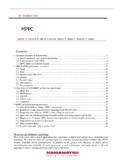Transcription of Schematic structure of MCP - Hamamatsu Photonics
1 HOW TO HANDLEWARRANTY PERIOD AND COVERAGEWARRANTY PERIOD AND COVERAGEMCP (MICROCHANNEL PLATE)AND MCP ASSEMBLYHOW TO HANDLE1 MCP (microchannel plate) is a two-dimensional sensor that detects electrons, ions, vacuum UV rays, X-rays and gamma rays in a vacuum, and amplifies the detected signals. Circular and rectangular MCPs are available in various dimensions, including easy-to-use MCP assemblies with pre-mounted electrode leads and supports. These MCPs are widely used in many types of analytical equipment such as for "mass spectroscopy", "semiconductor inspection" and "surface analysis".The MCP assemblies are available with three different readout devices to meet application needs.
2 The devices are of: (1) single anode (electrical output signal measurement within effective area), (2) multianode (electrical output signal measurement correspond-ing to signal input positions), and (3) phosphor screen (optical imaging of output signal). Select the output device that best matches your one to three stage MCPs can be selected for the assembly to obtain necessary gain, allowing uses in the analog mode (the output signal is measured as a continuous electrical current) or the counting mode ( the low level signal can be measured by a binary processing). As shown in the figure on the lower right, a potential gradient is established along the channel when the voltage VD is applied between the input and output sides of the MCP.
3 Multiple secondary electrons are emitted when an electron enters a channel from the input side and strikes its inner wall. These secondary electrons are accelerated by the potential gradient to draw parabolic trajecto-ries that are determined by their initial velocities. They then strike the opposite wall in the channel causing further secondary electrons to be emitted. The electrons in this way travel towards the output end while striking the inner wall of the channel repeatedly. As a result, a large number of exponentially increased electrons are extracted from the output thickness of an MCP is nearly equal to the channel length. The ratio of the channel length (L) to the channel diameter (d) is referred to as ( =L/d), and this and the secondary emission factor inherent to the channel wall material determine the gain of the MCP.
4 Standard MCPs are fabricated so that is 40 to 60. The MCP thickness is therefore determined by the required chan-nel diameter and the design value of this . Schematic structure of MCPTMCPC0002EF ThicknessThe bias angle is an angle formed by the channel axis and the axis perpendicular to the plate surface. This angle is chosen by considering the detection efficiency and spatial resolution as well as the prevention of input signals from passing through the chan-nels without colliding with the channel walls. The optimum value is usually from 5 to 15 . Bias angleThe OAR indicates the ratio of the channel open area to the entire effective area of and MCP.
5 Open Area Ratio: OARCHANNELDIAMETER: dLENGTH: LCHANNEL WALLSTRIPCURRENTINCIDENT ELECTRONOUTPUT ELECTRONSVDOUTPUT SIDE ELECTRODEINPUT SIDEELECTRODEOVERVIEWOVERVIEWOPERATING PRINCIPLEOPERATING PRINCIPLEOVERVIEWOVERVIEWOPERATING PRINCIPLEOPERATING PRINCIPLEThe open area ratio (OAR) of standard MCPs is normally set to 60 %, but we also provide "funnel type" MCPs whose open area ratio is improved up to 90 % in order to guide more signals into each channel. Please contact us if you are interested in funnel type MCP gain characteristics Pulse height distribution (PHD)TMCPB0005 EBTMCPB0034ED MCP saturation characteristics (output linearity)TMCPB0072 EBTMCPB0042 EFAnalog modeCounting VOLTAGE (kV)GAIN1061071081 STAGE MCP2 STAGE MCP3 STAGE MCPPULSE HEIGHT (CHANNEL NUMBER)NUMBER OF COUNTS (S-1)2 STAGE MCP3 STAGE MCP15010050010-810-710-610-510-4 OUTPUT CURRENT (A)RELATIVE GAIN (%)WIDE DYNAMIC RANGE MCPRESISTANCE: M EFFECTIVE AREA: 20 mmSTANDARD MCPRESISTANCE: 200 M EFFECTIVE AREA: 20 mm10810-810-710-610-510-4 OUTPUT CURRENT (A)NUMBER OF COUNTS (s-1)107106105104 WIDE DYNAMIC RANGE MCPRESISTANCE: M / 2 STAGE MCPGAIN.
6 8 106 EFFECTIVE AREA: 20 mmSTANDARD MCPRESISTANCE: 400 M / 2 STAGE MCPGAIN: 5 106 EFFECTIVE AREA: 20 mmIonChannel12 mIonChannel12 mCross-sectional view Shape of channel entrance (SEM image) Shape of channel entrance (SEM image)Cross-sectional viewCHARACTERISTICSCHARACTERISTICSLARGE OAR: FUNNEL TYPE (OPTION)LARGE OAR: FUNNEL TYPE (OPTION)CHARACTERISTICSCHARACTERISTICSLA RGE OAR: FUNNEL TYPE (OPTION)LARGE OAR: FUNNEL TYPE (OPTION)StandardOAR 60 %FunnelOAR 90 %3 Circular MCPTMCPA0056 EAMCPF0006 NOTE: 1 Indicates MCP input side. Shape varies depending on product current is the current that flows through channel walls when a voltage is applied between MCP IN and OUT.
7 It is given by dividing the applied voltage by the MCP voltage: kV, vacuum: 10-4 Pa, operating ambient temperature: +25 C4 Vacuum: 10-4 Pa5 The F1551-01, F1094-01, F1552-01, F1208-01 and F1217-01 are also available with a center through-hole (6 mm diameter).Unitmmmmmmmm m mdegrees% M pA cm-2 kV CF1552 -015-011-074F1094 -015-074-011 -015-011-074 2010 to % of strip current to +70815 to 200 to 10310 to to to 10320 to 200 17 to 10012850 to 500 ParameterTypeOuter size AElectrode area BEffective area CThickness DChannel diameterChannel pitchBias angle Open area ratioElectrode materialGain (Min.) 3 Resistance 3 Dark current (Max.)
8 3 Maximum linear output 3 Supply voltage 4 Operating ambient temperature 112 1055 to 50F1942-04 7710 to 100810 to 200121044 to 20 49 -015-011 to 200125318F1217 INDICATOR 1D ABCOUTPUT SIDEINPUT SIDEMCP MCP SPECIFICATIONS AND DIMENSIONAL OUTLINESSPECIFICATIONS AND DIMENSIONAL OUTLINESMCP MCP SPECIFICATIONS AND DIMENSIONAL OUTLINESSPECIFICATIONS AND DIMENSIONAL OUTLINES4 Rectangular MCPU nitmmmmmmmm m mdegrees% M pA cm-2 kV to 1355 3945 3520 to % of strip current to + 3781 5853 to to 50 ParameterTypeOuter size A A'Electrode size B B'Effective area C C'Thickness DChannel diameterChannel pitchBias angle Open area ratioElectrode materialGain (Min.)
9 3 Resistance 3 Dark current (Max.) 3 Maximum linear output 3 Supply voltage 4 Operating ambient temperature 4 TMCPA0057 EAMCPF0011 CBADINDICATOR 1 C B A INPUT SIDEOUTPUT SIDE5 Target object+/- and4 m MCPFast timeresponseFloatingAnodegroundPageStand ardCircular and rectangular types are circular type also includes an even smaller to 3 MCPs can be added according to level of X-rays or electrons to be detected. The screw mount allows easy replacement of the MCP and readout holeThis type of MCP assembly has a through-hole in the center that allows ions, X-rays and so on to pass through it to irradiate a sample. The signal from the sample can then be detected responseUsing an anode specially designed for the high-speed signal readout, this type of MCP assembly eliminates signal distortions called "ringing" and ensures an accurate signal output.
10 ION, X-RAY, WAVEFORMS ignal AmountMeasurementTOF(Time of Flight)DetectionMeasures the signal amountMeasures the difference in the arrival timeFLANGESIGNAL READOUT LEADMCPMCP ASSEMBLY MCP ASSEMBLY SELECTION GUIDE BY PURPOSESELECTION GUIDE BY PURPOSEMCP ASSEMBLY MCP ASSEMBLY SELECTION GUIDE BY PURPOSESELECTION GUIDE BY PURPOSEMCPF0081 MCPF00886 MCPR eadout device1: Single anode2: Multianode3: Phosphor type is compact, light in weight and economical. Unlike the demountable type, however, the assembled MCP cannot be phosphor screen coated on the glass plate converts the output charge distribution from the MCP into a visible image. A resolution of 40 m to 50 m can be obtained with a one-stage MCP, and that of 80 m to 100 m can be done with a two-stage MCP.

















